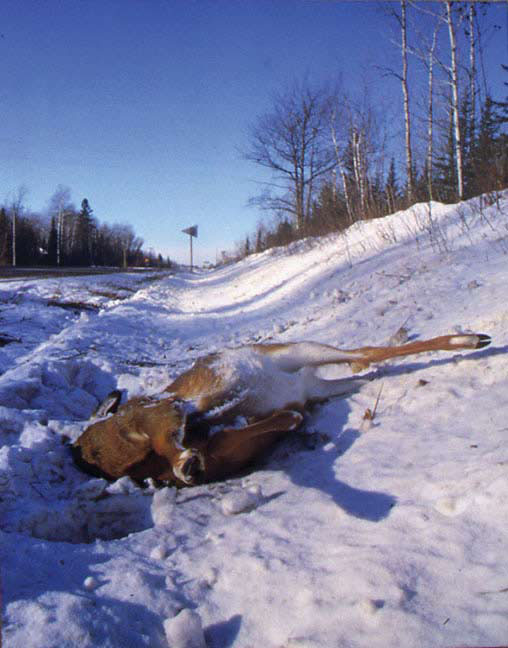Art Review: Mortality in Deer and Infants at the Soap
Jakki Spicer here reviews the Project Rooms now up at the Soap Factory.


Soap Factory Project Rooms: Suzanne Szucs, “Road Work: Deer Project;” and Dave Beck, “Reconciled (Red, Pink, Blue, Purple, White, Lilac, Baby Blue)”
Suzanne Szucs presents beautifully muted giclée prints of road kill. Deer, to be precise, splayed on beaches, highways, and fields, dead. The process of giclée does produce a beautiful print—painterly, with clean lines and muted luminosity. One can admire the soft clouds brushed across a icy blue sky, the graininess of the sand, the individual hairs of the deer’s fur, the startling red of their fatal wounds.
It is strange walking into this room, which is situated between two other gallery spaces containing the Soap Factory’s “Your Heart is No Match for My Love” exhibit. The pieces in this group show are, as the title implies, about the loneliness, obsessions, and paranoia of love. The proximity between this show and Szucs’ project room, most likely nothing more than coincidental, situates the mangled, broken deer carcasses as objects of love as well. And Szucs does render them lovingly—the prints are beautiful: crisp landscapes with a studied attention to color and composition, they breathe the calm, peaceful breath of winter solitude. Except, of course, for the deer, nearly always at the center of one’s sight-line, unmistakably and violently dead.
The pieces predominate in their cool blues, whites, and browns, and yet almost all set these against the red wound of the deer—a bit of brain matter here, a flayed leg muscle there, perhaps a deer-sized pool of blood staining the road. It startles, the color and content of these injuries, and yet one is drawn in, not as a prurient gawker, but with a certain affection. The images, results of certainly violent encounters, present a sort of peaceful contemplation that one is only occasionally startled out of, like a sudden tire squeal in an otherwise quiet night.
There are no figures in the scenes other than the deer, and thus the viewer must relate, if relate at all, to those carcasses. Perhaps the most eerie of the prints is not “53 South, Wisconsin, Highway 2 Turnoff, #2,” where the glassy eye of the deer stares back at the camera, while the blinding orb of the sun glares menacingly out from behind a small wood. Instead, it is probably “Arrowhead and Cramer, Duluth,” where the deer carcass is inexplicably deposited next to someone’s driveway, as if it belonged to the landscape as much as the mailbox does, or the stop sign on the corner.
The aesthetic serenity of “Road Work: Deer Project” acts as a silencer of the frighteningly loud impact that must have occasioned these scenarios. What we are left with is that uncanny sense of disquiet and peace that comes from trying to love something that is already dead.
Dave Beck’s “Reconciled (Red, Pink, Blue, Purple, White, Lilac, Baby Blue)” reverses this strange love. His sculptures—oddly arranged, plaster-filled, inside-out, footed baby pajamas—do not evoke love for what normally seems repulsive. Instead, they suggest a beleaguered resentment of what is supposed to be most loveable—the baby. The word that technically denotes this admixture of love and hate that one feels for a needy baby, ambivalence, seems, oddly, the least appropriate word for these works. Beck’s pieces do not speak of this charged conflict—and even less the wishy-washy indecisiveness that the term has come to mean—so much as they present the solidity of duty. It does not matter, in the end, whether one love the baby zipped into its fuzzy pjs. One is required, regardless, to carry its heaviness in one’s arms, to care for its unyielding demands.
These works are repulsive in their marshmallowy cuteness, their bloated limbs and contorted positions. They occupy a space between heaviness and lightness, softness and hardness, and their refusal to give over to either quality makes them infuriating and disconcerting; each piece’s lumpy, boneless shapes conjure up another flutter of uneasiness. Especially unnerving is “Pink,” wherein the pjs are arranged into a perfect limbless cylinder, briefly bringing to mind those old baby-in-a-blender jokes—or perhaps Garbage Pail Kids, both said to be signifiers of cultural anxieties about infants. Perhaps Beck does find the contrasting elements reconciled in his pieces, but their contradictions also invoke an irreconcilability that one accepts in the face of loving that which gives you no choice but to love it.